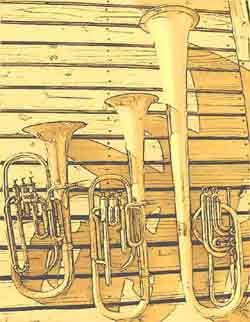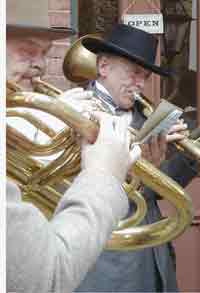The instruments used by the band are of the same vintage as those played by the original band in the mid 19th century. Instrumentation includes:
- E-flat Cornets
- B-flat Cornets
- E-flat Alto horns
- B-flat Tenor/Baritones
- E-flat Basses
- Percussion
The instruments played by the band are all period. No reproduction horns were used. All the horns date from the Civil War era and a short time before.
Some dating back to the mid 1840's. The instruments have been restored to as near their original condition
as possible, allowing the instruments to once again play the music they did over a century ago.
Among instruments making up the band are valved bugles, cornets, and an assortment of various designs
of alto, tenor, baritone and bass saxhorns, and rope tension drums.
The Pedigree of the Civil War Brass Instruments
The story of the development of the instruments used in the Civil War is in many ways a parallel to the economic, social and developments of the time.
The instruments, themselves, were generally described as 'saxhorns', and thus have been the source of much discussion and disagreement ever since. The saxhorns can correctly be described as a family of instruments in many different pitches that share the characteristic of having conical tubing which starts small at the mouthpiece and expands throughout the instrument except in the valve section. They use the valved bugle as their template, which is the ancestor of the modern cornet.
It is difficult to add much more to the definition of these instruments, as there was so much variation and experimentation in design. They came in a variety of shapes, bore profile of the flare, types and number of valves, type of mouthpieces used, etc.
 They were distinct from the cylindrical tubing of the trumpet and trombone families, where the majority of the tubing is of the same diameter. The horns of the today that go by the name of trumpet are actually trumpet shaped cornets. One does not hear the brilliant voice of the true trumpet in the modern band.
They were distinct from the cylindrical tubing of the trumpet and trombone families, where the majority of the tubing is of the same diameter. The horns of the today that go by the name of trumpet are actually trumpet shaped cornets. One does not hear the brilliant voice of the true trumpet in the modern band.
Adolphe Sax has lent his name to this family of instruments, not because he invented them, but rather because he was a manufacturer of superior quality instruments, and because he successfully marketed a concept. Sax was concerned with his own financial success, but more importantly, he saw an instrument not so much as a specific device but rather as a collection of underlying acoustic, physical, and mechanical principles. Further, he saw that by using instruments in homogeneous groups, a band became a single instrument.
The first half of the 19th Century was a period of rapid change in society and industry, as well as in music. And, each of these overlapped and affected the other. Innovations in industry such as the valve used in mining operations were adapted and applied to musical instruments. And, the band was used as a technique to retain and control employees by the managers of industry. Increased efficiency of industry impacted society by allowing more people the luxury of free time. Free time provided the opportunity for bands to develop to provide entertainment. Music was no longer exclusive to the privileged class. As society developed a taste for entertainment, new industries were spawned to manufacture the tools of the entertainers, such as brass instruments.
The introduction of the valve to brass instruments, rapidly following the earlier introduction of keyed brass, triggered a creative explosion in the 19th century. Indeed, creativity was a characteristic of all of society at the time; it was happening everywhere, in all things. There was an avalanche of change in a short period of time, and the recorders of history of the time often failed to always distinguish what was insignificant tinkering unworthy of documentation and what was meaningful development, consequently, there are gaps in the documentation of the development of the brasswind family.
The mid-1830's saw the establishment of several bands consisting entirely of brass instruments and they began to supplant the bands of mixed woodwind and brass. One of the first was the Dodworth Band of New York which dispensed with woodwinds in 1834. It is likely that the bass part was still played on an ophicleide since Dodworth's over-the-shoulder instruments were not patented until 1838 and the Ebor Corno valve instruments, also a Dodworth invention, were built only in alto and tenor sizes. Initially, Uhlmann of Vienna made the OTS instruments for Dodworth.  Dodworth developed the OTS horns as marching instruments only, and proclaimed them to be unsuitable for concert work. These instruments were developed prior to Sax's 'invention' of the saxhorn.
Dodworth developed the OTS horns as marching instruments only, and proclaimed them to be unsuitable for concert work. These instruments were developed prior to Sax's 'invention' of the saxhorn.
It is difficult to establish a date for the introduction of the saxhorn. There is no distinguishing feature of the individual saxhorn that separates it from other instruments previously created.
Yet, 1845 is a pivotal date in the proliferation of saxhorns. Military bands in France were comprised of instruments some of which, Sax wrote "especially the horns and the bassoons were not fitted for open-air performances. The sounds of the musical units were lacking in homogeneity; the high-pitched piccolo and the clarinets gave out squeaky sounds, while the ophicleides snorted and shouted. And most of the intermediary instruments were squeezed between these two extremes and their sound could hardly be perceived." Sax proposed to make use of saxhorns to take advantage of employing a group of instruments of the same family, "which would permit the melodic line to pass smoothly from one instrument to another as it does in the string quartet, or as it passes from one voice to another as it does in a well trained choir." A contest was arranged from which Sax was the winner. And his concept spread throughout the Western World. Society had developed a fondness for loud chromatic-playing bands.
By 1855 Dodworth would write:
"All brass instruments are classed as Sopranos, Altos, Tenores, Baritones, Bases and Contra Basses. It would, perhaps, be more correct to use the Italian plural to these words, but as the English plural is more generally made use of, it has been adopted here. The various instruments comprising each class, are enumerated as follows:
1st CLASS-Sopranos. Eb Bugles, Eb Sax Horns, Eb Cornets, and all other small instruments in Ab, F or Eb.
2nd CLASS-Altos. Bb Bugles, Bb Sax Horn, Bb Cornet, Post Horn or Trumpets-a forth below the Sopranos.
3rd CLASS-Tenores. Ebor Cornos, Sax Horns, Alt horns, Neo Cors, Tenore Ophicleide, Tenore Tubas, Alto Trombones, French Horns-all an octave below the Sopranos.
4th CLASS-Baritones. Baritone Sax Horns, Bb Trombones, Valve Trombones-all an octave below the Altos.
5th CLASS- Basses. C and Bb Ophicleide's, Sax Horns, Bb Tubas - all in C, Bb or Ab, same pitch as Baritones, but with larger tubing.
6th CLASS-Contra Basses. Bass Tubas, Sax Horns, Bombardons, Tromacellos, Bass Trombones, mostly in F or Eb-octave lower than the Tenores. Some are in Db.
Instruments are again divided into families, as follows:
1st. Sax Horns, Cornets, and Ebor Cornos.
2d. Bugles and Ophicleides
3d. Trumpets, Post Horns and Trombones; these instruments having the same characteristics of voice, are for that reasons appropriately classes as families. I have always, in my own mind, classed Trumpets, Post Horns, Trombones and French Horns, as supernumeraries; for since the introduction of the Bugles, Cornets, Ebor Cornos, a and Sax Horns, they are no longer depended upon for the principal parts."
The simple truth is that there was a babel of nomenclature at the time that freely used or mis-used the names of several instruments, including the Saxhorns, the cornets, the Eb soprano and Bb alto, fluglehorns, "pikkolo" and the "petite bugle". There was also the "cornetto", which was a variation of the valved Post horn (not to be confused with certain zincks/cornetti bearing the same name).
In addition, a lot of instruments of this period did not follow instrument bore-profile guidelines, and for good reason. They were effectively forced to fudge and fiddle with perfectly good designs. Because of the existing patent laws, many good instrument builders had to break the rules to enter the market. Some rule breaking may have been for musical innovation, but much was simply a marketing maneuver.
Nevertheless, brass bands were a new market. The new valved instruments were easier to master than their predecessors. The natural trumpets and horns were only agile in the hands of skilled professionals. Additionally, they were not instruments that amateurs would have owned or had access to. The classical world of that period was very insular, with composition and performance techniques being very closely guarded secrets between teachers and carefully groomed and selected pupils.
Brass bands were within reach of common people. And, as the only source of this new style of music, there not being any means of recording and replaying; if you didn't have a band, you didn't have the music.
And, the horns came in many wonderful varieties, but at a price. Very little had been standardized at that time. So manufacturers would make their instruments at a pitch of their own choosing. Mixing instruments of different manufacture was problematic. Consequently, it was common practice to purchase band instruments as a group.
 The valves might be Wieprecht's Berliner pumpen, Stoelzel, or Uhlmann's Vienna piston or Perinet valve or a Reidl rotary valve.
The valves might be Wieprecht's Berliner pumpen, Stoelzel, or Uhlmann's Vienna piston or Perinet valve or a Reidl rotary valve. 
Bells would point forward, up or backward,
 |  |  |
the horn may be round  or rectangular, or it may wrap around the trunk of the player. They might have 3, 4, or 5 valves. The overall instrument might be petite and slender, or it may be substantial and expansive.
or rectangular, or it may wrap around the trunk of the player. They might have 3, 4, or 5 valves. The overall instrument might be petite and slender, or it may be substantial and expansive.
But they were in the hands of everyman and in whose hands they remain.

